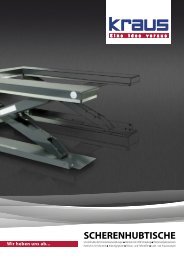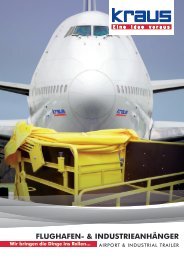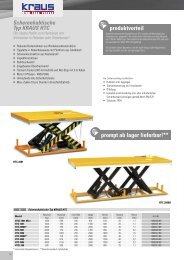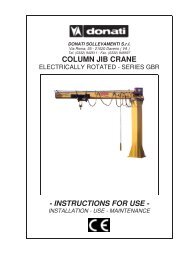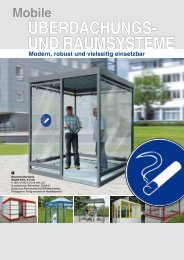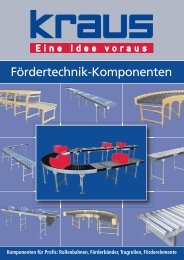JIB CRANES WITH AN ARTICULATED ARM MANUALLY ROTATED
JIB CRANES WITH AN ARTICULATED ARM MANUALLY ROTATED
JIB CRANES WITH AN ARTICULATED ARM MANUALLY ROTATED
Create successful ePaper yourself
Turn your PDF publications into a flip-book with our unique Google optimized e-Paper software.
DONATI SOLLEVAMENTI S.r.l. - Via Roma, 55 - 21020 Daverio (VA) - Tel. 0332 942611 - Fax. 0332 948597<br />
6.3.3 Check of efficiency of parts and components.<br />
For the individual parts of the jib crane the following instructions must be strictly<br />
adhered to:<br />
Annual check of the efficiency of structural elements, welding, pivots and<br />
bolted couplings ( fig.54 ):<br />
• The metal structures of the jib crane, as well as normal alterations due to environmental<br />
factors and wear of mobile parts (hinges), can be subject, even inadvertently or during<br />
handling operations, to bumps, contact or grazing with other equipment or to anomalous<br />
strain which can cause damage to the frames, welding and pivots. Therefore, after careful<br />
cleaning, the structures must periodically undergo scrupulous checks to ensure their<br />
suitability and if necessary, any damage be remedied.<br />
• The brackets, composed of plates and pivot, which form hinged elements, are subject to<br />
wear as they are mobile, swinging elements exposed to sliding friction in the areas of<br />
contact. If excessive wear is found, substitute them during the check.<br />
• All screw bolts, high resistance plugs and pins must be disassembled and carefully checked<br />
annually, and so must the relative seatings.<br />
• Check the clamping couple of the fixing bolts of the column and the bracket, according to the<br />
given couples (see tables on page 12).<br />
Repair or substitute hinged parts where one finds:<br />
• deformation: lengthening, crushing, staining, bending<br />
• wear: worn parts, scarcement, incisions, abrasions, corrosion, oxidation,<br />
scratching, peeling point<br />
• breakage: cracks in the welding, cracking, cuts or incisions, broken parts<br />
• variation of a section ≥�10%, or of the diameter or thickness ≥�5% compared to<br />
initial values<br />
fig.54<br />
52<br />
TECNICO<br />
DONATI<br />
DONATI<br />
SERVICE



